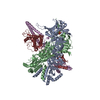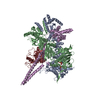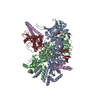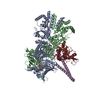+ Open data
Open data
- Basic information
Basic information
| Entry | Database: PDB / ID: 5fwm | |||||||||
|---|---|---|---|---|---|---|---|---|---|---|
| Title | Atomic cryoEM structure of Hsp90-Cdc37-Cdk4 complex | |||||||||
 Components Components |
| |||||||||
 Keywords Keywords |  CHAPERONE / CHAPERONE /  HSP90 / HSP90 /  CDC37 / CDC37 /  CDK4 / CDK4 /  KINASE / UNFOLDING KINASE / UNFOLDING | |||||||||
| Function / homology |  Function and homology information Function and homology informationcyclin D3-CDK4 complex / cyclin D1-CDK4 complex / cyclin D2-CDK4 complex / Evasion of Oncogene Induced Senescence Due to Defective p16INK4A binding to CDK4 / Evasion of Oxidative Stress Induced Senescence Due to Defective p16INK4A binding to CDK4 / cellular response to ionomycin / regulation of transcription initiation by RNA polymerase II / regulation of type II interferon-mediated signaling pathway / Drug-mediated inhibition of CDK4/CDK6 activity / Evasion of Oncogene Induced Senescence Due to Defective p16INK4A binding to CDK4 and CDK6 ...cyclin D3-CDK4 complex / cyclin D1-CDK4 complex / cyclin D2-CDK4 complex / Evasion of Oncogene Induced Senescence Due to Defective p16INK4A binding to CDK4 / Evasion of Oxidative Stress Induced Senescence Due to Defective p16INK4A binding to CDK4 / cellular response to ionomycin / regulation of transcription initiation by RNA polymerase II / regulation of type II interferon-mediated signaling pathway / Drug-mediated inhibition of CDK4/CDK6 activity / Evasion of Oncogene Induced Senescence Due to Defective p16INK4A binding to CDK4 and CDK6 / Evasion of Oxidative Stress Induced Senescence Due to Defective p16INK4A binding to CDK4 and CDK6 / regulation of type B pancreatic cell proliferation / : / HSP90-CDC37 chaperone complex / positive regulation of cyclin-dependent protein kinase activity / positive regulation of mitophagy in response to mitochondrial depolarization / Aryl hydrocarbon receptor signalling / negative regulation of proteasomal protein catabolic process / dynein axonemal particle /  aryl hydrocarbon receptor complex / aryl hydrocarbon receptor complex /  histone methyltransferase binding / Transcriptional regulation by RUNX2 / cellular response to phorbol 13-acetate 12-myristate / protein kinase regulator activity / positive regulation of protein localization to cell surface / ATP-dependent protein binding / protein folding chaperone complex / negative regulation of protein metabolic process / cyclin-dependent protein serine/threonine kinase regulator activity / positive regulation of tau-protein kinase activity / post-transcriptional regulation of gene expression / histone methyltransferase binding / Transcriptional regulation by RUNX2 / cellular response to phorbol 13-acetate 12-myristate / protein kinase regulator activity / positive regulation of protein localization to cell surface / ATP-dependent protein binding / protein folding chaperone complex / negative regulation of protein metabolic process / cyclin-dependent protein serine/threonine kinase regulator activity / positive regulation of tau-protein kinase activity / post-transcriptional regulation of gene expression /  telomerase holoenzyme complex assembly / Uptake and function of diphtheria toxin / Drug-mediated inhibition of ERBB2 signaling / Resistance of ERBB2 KD mutants to trastuzumab / Resistance of ERBB2 KD mutants to sapitinib / Resistance of ERBB2 KD mutants to tesevatinib / Resistance of ERBB2 KD mutants to neratinib / Resistance of ERBB2 KD mutants to osimertinib / Resistance of ERBB2 KD mutants to afatinib / Resistance of ERBB2 KD mutants to AEE788 / Resistance of ERBB2 KD mutants to lapatinib / telomerase holoenzyme complex assembly / Uptake and function of diphtheria toxin / Drug-mediated inhibition of ERBB2 signaling / Resistance of ERBB2 KD mutants to trastuzumab / Resistance of ERBB2 KD mutants to sapitinib / Resistance of ERBB2 KD mutants to tesevatinib / Resistance of ERBB2 KD mutants to neratinib / Resistance of ERBB2 KD mutants to osimertinib / Resistance of ERBB2 KD mutants to afatinib / Resistance of ERBB2 KD mutants to AEE788 / Resistance of ERBB2 KD mutants to lapatinib /  Drug resistance in ERBB2 TMD/JMD mutants / TPR domain binding / PTK6 Regulates Cell Cycle / positive regulation of transforming growth factor beta receptor signaling pathway / regulation of cyclin-dependent protein serine/threonine kinase activity / dendritic growth cone / Defective binding of RB1 mutants to E2F1,(E2F2, E2F3) / regulation of type I interferon-mediated signaling pathway / positive regulation of phosphoprotein phosphatase activity / Sema3A PAK dependent Axon repulsion / The NLRP3 inflammasome / regulation of protein ubiquitination / HSF1-dependent transactivation / telomere maintenance via telomerase / negative regulation of proteasomal ubiquitin-dependent protein catabolic process / response to unfolded protein / bicellular tight junction / cyclin-dependent protein kinase holoenzyme complex / HSF1 activation / Drug resistance in ERBB2 TMD/JMD mutants / TPR domain binding / PTK6 Regulates Cell Cycle / positive regulation of transforming growth factor beta receptor signaling pathway / regulation of cyclin-dependent protein serine/threonine kinase activity / dendritic growth cone / Defective binding of RB1 mutants to E2F1,(E2F2, E2F3) / regulation of type I interferon-mediated signaling pathway / positive regulation of phosphoprotein phosphatase activity / Sema3A PAK dependent Axon repulsion / The NLRP3 inflammasome / regulation of protein ubiquitination / HSF1-dependent transactivation / telomere maintenance via telomerase / negative regulation of proteasomal ubiquitin-dependent protein catabolic process / response to unfolded protein / bicellular tight junction / cyclin-dependent protein kinase holoenzyme complex / HSF1 activation /  protein targeting / chaperone-mediated protein complex assembly / Attenuation phase / protein targeting / chaperone-mediated protein complex assembly / Attenuation phase /  cyclin-dependent kinase / RHOBTB2 GTPase cycle / cyclin-dependent protein serine/threonine kinase activity / cyclin-dependent kinase / RHOBTB2 GTPase cycle / cyclin-dependent protein serine/threonine kinase activity /  Purinergic signaling in leishmaniasis infection / Purinergic signaling in leishmaniasis infection /  DNA polymerase binding / supramolecular fiber organization / axonal growth cone / Signaling by ERBB2 / positive regulation of telomerase activity / HSP90 chaperone cycle for steroid hormone receptors (SHR) in the presence of ligand / DNA polymerase binding / supramolecular fiber organization / axonal growth cone / Signaling by ERBB2 / positive regulation of telomerase activity / HSP90 chaperone cycle for steroid hormone receptors (SHR) in the presence of ligand /  heat shock protein binding / positive regulation of G2/M transition of mitotic cell cycle / regulation of G2/M transition of mitotic cell cycle / cellular response to interleukin-4 / nitric-oxide synthase regulator activity / heat shock protein binding / positive regulation of G2/M transition of mitotic cell cycle / regulation of G2/M transition of mitotic cell cycle / cellular response to interleukin-4 / nitric-oxide synthase regulator activity /  cyclin binding / Constitutive Signaling by Overexpressed ERBB2 / ESR-mediated signaling / placenta development / response to organic substance / Ubiquitin-dependent degradation of Cyclin D / positive regulation of cell differentiation / cyclin binding / Constitutive Signaling by Overexpressed ERBB2 / ESR-mediated signaling / placenta development / response to organic substance / Ubiquitin-dependent degradation of Cyclin D / positive regulation of cell differentiation /  peptide binding / ATP-dependent protein folding chaperone / Signaling by ERBB2 TMD/JMD mutants / peptide binding / ATP-dependent protein folding chaperone / Signaling by ERBB2 TMD/JMD mutants /  Hsp90 protein binding / G1/S transition of mitotic cell cycle / tau protein binding / DDX58/IFIH1-mediated induction of interferon-alpha/beta / Constitutive Signaling by EGFRvIII / Signaling by ERBB2 ECD mutants / Oncogene Induced Senescence / Signaling by ERBB2 KD Mutants / Regulation of necroptotic cell death / Regulation of actin dynamics for phagocytic cup formation / RMTs methylate histone arginines Hsp90 protein binding / G1/S transition of mitotic cell cycle / tau protein binding / DDX58/IFIH1-mediated induction of interferon-alpha/beta / Constitutive Signaling by EGFRvIII / Signaling by ERBB2 ECD mutants / Oncogene Induced Senescence / Signaling by ERBB2 KD Mutants / Regulation of necroptotic cell death / Regulation of actin dynamics for phagocytic cup formation / RMTs methylate histone argininesSimilarity search - Function | |||||||||
| Biological species |   HOMO SAPIENS (human) HOMO SAPIENS (human) | |||||||||
| Method |  ELECTRON MICROSCOPY / ELECTRON MICROSCOPY /  single particle reconstruction / single particle reconstruction /  cryo EM / Resolution: 8 Å cryo EM / Resolution: 8 Å | |||||||||
 Authors Authors | Verba, K.A. / Wang, R.Y.R. / Arakawa, A. / Liu, Y. / Yokoyama, S. / Agard, D.A. | |||||||||
 Citation Citation |  Journal: Science / Year: 2016 Journal: Science / Year: 2016Title: Atomic structure of Hsp90-Cdc37-Cdk4 reveals that Hsp90 traps and stabilizes an unfolded kinase. Authors: Kliment A Verba / Ray Yu-Ruei Wang / Akihiko Arakawa / Yanxin Liu / Mikako Shirouzu / Shigeyuki Yokoyama / David A Agard /   Abstract: The Hsp90 molecular chaperone and its Cdc37 cochaperone help stabilize and activate more than half of the human kinome. However, both the mechanism by which these chaperones assist their "client" ...The Hsp90 molecular chaperone and its Cdc37 cochaperone help stabilize and activate more than half of the human kinome. However, both the mechanism by which these chaperones assist their "client" kinases and the reason why some kinases are addicted to Hsp90 while closely related family members are independent are unknown. Our structural understanding of these interactions is lacking, as no full-length structures of human Hsp90, Cdc37, or either of these proteins with a kinase have been elucidated. Here we report a 3.9 angstrom cryo-electron microscopy structure of the Hsp90-Cdc37-Cdk4 kinase complex. Surprisingly, the two lobes of Cdk4 are completely separated with the β4-β5 sheet unfolded. Cdc37 mimics part of the kinase N lobe, stabilizing an open kinase conformation by wedging itself between the two lobes. Finally, Hsp90 clamps around the unfolded kinase β5 strand and interacts with exposed N- and C-lobe interfaces, protecting the kinase in a trapped unfolded state. On the basis of this structure and an extensive amount of previously collected data, we propose unifying conceptual and mechanistic models of chaperone-kinase interactions. | |||||||||
| History |
|
- Structure visualization
Structure visualization
| Movie |
 Movie viewer Movie viewer |
|---|---|
| Structure viewer | Molecule:  Molmil Molmil Jmol/JSmol Jmol/JSmol |
- Downloads & links
Downloads & links
- Download
Download
| PDBx/mmCIF format |  5fwm.cif.gz 5fwm.cif.gz | 609.7 KB | Display |  PDBx/mmCIF format PDBx/mmCIF format |
|---|---|---|---|---|
| PDB format |  pdb5fwm.ent.gz pdb5fwm.ent.gz | 508.8 KB | Display |  PDB format PDB format |
| PDBx/mmJSON format |  5fwm.json.gz 5fwm.json.gz | Tree view |  PDBx/mmJSON format PDBx/mmJSON format | |
| Others |  Other downloads Other downloads |
-Validation report
| Arichive directory |  https://data.pdbj.org/pub/pdb/validation_reports/fw/5fwm https://data.pdbj.org/pub/pdb/validation_reports/fw/5fwm ftp://data.pdbj.org/pub/pdb/validation_reports/fw/5fwm ftp://data.pdbj.org/pub/pdb/validation_reports/fw/5fwm | HTTPS FTP |
|---|
-Related structure data
| Related structure data |  3342MC  3337C  3338C  3339C  3340C  3341C  3343C  3344C  5fwkC  5fwlC  5fwpC C: citing same article ( M: map data used to model this data |
|---|---|
| Similar structure data |
- Links
Links
- Assembly
Assembly
| Deposited unit | 
|
|---|---|
| 1 |
|
- Components
Components
| #1: Protein |  Heat shock response / HSP 90 / HEAT SHOCK 84 KDA / HSP 84 / HSP84 / HEAT SHOCK PROTEIN HSP 90 BETA Heat shock response / HSP 90 / HEAT SHOCK 84 KDA / HSP 84 / HSP84 / HEAT SHOCK PROTEIN HSP 90 BETAMass: 83645.539 Da / Num. of mol.: 2 Source method: isolated from a genetically manipulated source Source: (gene. exp.)   HOMO SAPIENS (human) / Plasmid: PFASTBACHT / Production host: HOMO SAPIENS (human) / Plasmid: PFASTBACHT / Production host:   SPODOPTERA FRUGIPERDA (fall armyworm) / References: UniProt: P08238 SPODOPTERA FRUGIPERDA (fall armyworm) / References: UniProt: P08238#2: Protein | | Mass: 44622.363 Da / Num. of mol.: 1 Source method: isolated from a genetically manipulated source Source: (gene. exp.)   HOMO SAPIENS (human) / Plasmid: PFASTBACHT / Production host: HOMO SAPIENS (human) / Plasmid: PFASTBACHT / Production host:   SPODOPTERA FRUGIPERDA (fall armyworm) / References: UniProt: Q16543 SPODOPTERA FRUGIPERDA (fall armyworm) / References: UniProt: Q16543#3: Protein | |  Mass: 34520.629 Da / Num. of mol.: 1 Source method: isolated from a genetically manipulated source Source: (gene. exp.)   HOMO SAPIENS (human) / Plasmid: PFASTBACHT / Production host: HOMO SAPIENS (human) / Plasmid: PFASTBACHT / Production host:   SPODOPTERA FRUGIPERDA (fall armyworm) / References: UniProt: P11802 SPODOPTERA FRUGIPERDA (fall armyworm) / References: UniProt: P11802#4: Chemical |  Adenosine triphosphate Adenosine triphosphate#5: Chemical | |
|---|
-Experimental details
-Experiment
| Experiment | Method:  ELECTRON MICROSCOPY ELECTRON MICROSCOPY |
|---|---|
| EM experiment | Aggregation state: PARTICLE / 3D reconstruction method:  single particle reconstruction single particle reconstruction |
- Sample preparation
Sample preparation
| Component | Name: COMPLEX OF HUMAN HSP90BETA, HUMAN CDC37 AND HUMAN CDK4 Type: COMPLEX |
|---|---|
| Buffer solution | Name: 20MM TRIS-HCL (PH 7.5), 150 MM NACL, 10 MM KCL, 10 MM MGCL2, 20 MM NA2MOO4, 2MM DTT, 0.085MM DDM pH: 7.5 Details: 20MM TRIS-HCL (PH 7.5), 150 MM NACL, 10 MM KCL, 10 MM MGCL2, 20 MM NA2MOO4, 2MM DTT, 0.085MM DDM |
| Specimen | Conc.: 0.27 mg/ml / Embedding applied: NO / Shadowing applied: NO / Staining applied : NO / Vitrification applied : NO / Vitrification applied : YES : YES |
| Specimen support | Details: HOLEY CARBON |
Vitrification | Instrument: FEI VITROBOT MARK III / Cryogen name: ETHANE / Details: LIQUID ETHANE |
- Electron microscopy imaging
Electron microscopy imaging
| Experimental equipment |  Model: Titan Krios / Image courtesy: FEI Company |
|---|---|
| Microscopy | Model: FEI TITAN KRIOS / Date: Nov 25, 2014 |
| Electron gun | Electron source : :  FIELD EMISSION GUN / Accelerating voltage: 300 kV / Illumination mode: OTHER FIELD EMISSION GUN / Accelerating voltage: 300 kV / Illumination mode: OTHER |
| Electron lens | Mode: BRIGHT FIELD Bright-field microscopy / Nominal magnification: 22500 X / Nominal defocus max: 3800 nm / Nominal defocus min: 1400 nm / Cs Bright-field microscopy / Nominal magnification: 22500 X / Nominal defocus max: 3800 nm / Nominal defocus min: 1400 nm / Cs : 2.7 mm : 2.7 mm |
| Image recording | Electron dose: 44 e/Å2 / Film or detector model: GATAN K2 SUMMIT (4k x 4k) |
- Processing
Processing
| EM software |
| ||||||||||||
|---|---|---|---|---|---|---|---|---|---|---|---|---|---|
| Symmetry | Point symmetry : C1 (asymmetric) : C1 (asymmetric) | ||||||||||||
3D reconstruction | Resolution: 8 Å / Num. of particles: 61981 / Actual pixel size: 1.315 Å Details: THIS MODEL WAS BUILT BASED ON 5FWK WITH CDK4 N-LOBE RIGID BODY FIT INTO THE EM DENSITY. THE MODEL WAS THEN MINIMIZED IN ROSETTA. SUBMISSION BASED ON EXPERIMENTAL DATA FROM EMDB EMD-3342. (DEPOSITION ID: 14285). Symmetry type: POINT | ||||||||||||
| Atomic model building | Protocol: OTHER / Details: METHOD--ROSETTA | ||||||||||||
| Refinement | Highest resolution: 8 Å | ||||||||||||
| Refinement step | Cycle: LAST / Highest resolution: 8 Å
|
 Movie
Movie Controller
Controller










 PDBj
PDBj




























